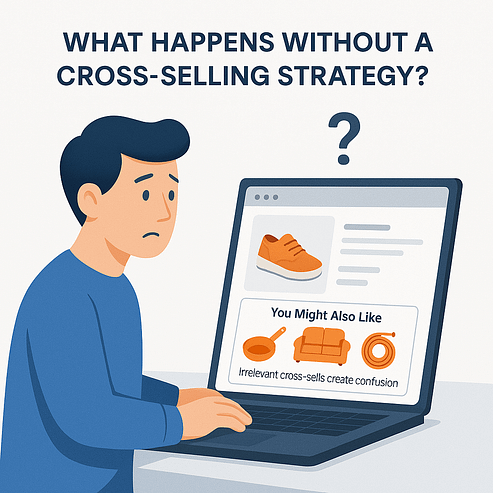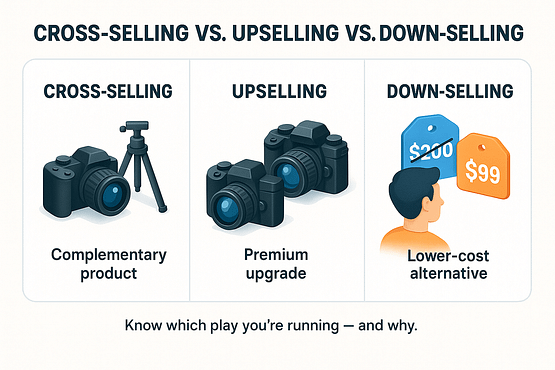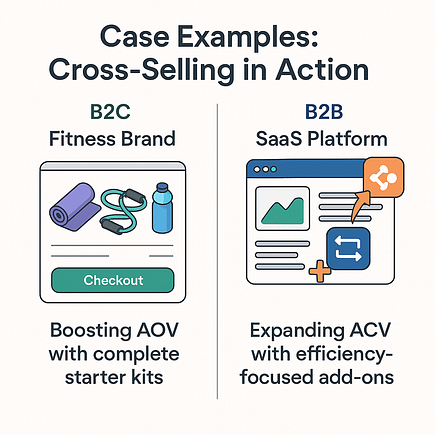What if I told you that cross-selling, when done right, can drive up to 42% more revenue for a business?
It’s a big number—and it raises an uncomfortable question: if the potential is that high, why do so many cross-sell attempts feel clumsy, irrelevant, or downright pushy?
You’ve seen it happen: random product suggestions jammed onto a checkout page, offers that don’t fit, and prompts that feel more like spam than support. Instead of building loyalty, they quietly chip away at it.
That’s exactly why I want to reframe the conversation. This isn’t about checkout widgets or lazy “related items” carousels. It’s about designing a cross-selling strategy that increases revenue and deepens trust at the same time.
And to set you up properly, I’m starting with the answers first.
The Top 10 Questions Every Cross-Selling Strategy Must Answer
When I first started working on cross-selling, I wish someone had just handed me a straight list of answers instead of making me dig through endless “tips and tricks.” So here it is—the shortcut I didn’t get. Think of this as your roadmap for the rest of the article.
Cross-selling is about adding something complementary to complete the customer’s purchase. Upselling is about replacing their choice with a more expensive version. One completes, the other upgrades. Different plays, different psychology.
After trust is established. That could be in-cart, on the thank-you page, or even post-purchase once the customer has started using the product. The timing sweet spot is when the customer sees value in their first choice and is most open to making it even better.
Look at the data and the customer’s bigger goal. Transaction history reveals obvious pairings (“customers who bought X also bought Y”), but the real wins come when you anticipate adjacent needs the customer hasn’t thought of yet.
In services or B2B, cross-selling isn’t a checkout prompt—it’s a consultative conversation. You’re not offering “more stuff,” you’re expanding the solution. Think training packages, integrations, or strategic add-ons that help the client achieve outcomes faster.
The test is simple: does the offer feel like a shortcut or a distraction? If it clearly adds value to the original purchase, it builds trust. If it feels like a cash grab, it erodes it.
At minimum: a CRM/CDP for customer data, an e-commerce/CMS platform that supports dynamic offers, and an automation tool for triggered emails or retargeting. Add analytics and A/B testing so you can learn fast.
AOV is the short-term signal. The long-term ones are Customer Lifetime Value (CLV), retention rate, and customer satisfaction scores. If your AOV is climbing while retention is falling, your cross-sell strategy is broken.
Reward relevance, not volume. If your incentives push staff to cram extra products into every conversation, customers will resent it. Incentives should track profitability, retention, and quality of fit.
- When the product is irrelevant.
- When the customer is unhappy or hasn’t seen value yet.
- When the offer could actually slow down or complicate their success.
Lead with transparency and suitability. The most profitable cross-sells are the ones customers thank you for later, not the ones they regret. Ethical = sustainable.
👉 These ten questions set the foundation. They’re the “answers first” approach I promised. Now, let’s dig deeper—because knowing the answers is only half the battle. You need to understand what happens when you don’t, and how to put the right system in place.
What Happens When You Don’t Have a Solid Cross-Selling Strategy?
I’ve seen it play out so many times: a business decides they need a “cross-sell strategy,” so they slap a “you might also like” carousel under a product and call it a day. The problem? That’s not a strategy—that’s a guessing game.
Without clarity, most companies end up **confusing cross-selling with upselling** or throwing irrelevant recommendations at customers who never asked for them. Instead of feeling supported, those customers feel like they’re dodging pop-up ads in disguise.

Behind the scenes, the data that could make those offers relevant sits in silos no one talks to. Marketing doesn’t know what sales knows, sales doesn’t know what support hears, and customers see the result: scattershot offers that don’t fit their needs.
And let’s be honest—teams aren’t exactly lining up to prioritize cross-selling either. Why would they, when their incentives usually stop at closing the first deal? So cross-selling gets treated like an afterthought, not a growth lever.
The outcome is predictable: customers tune out, revenue stalls, and brand trust quietly erodes. And once you lose that trust, no “limited-time bundle” is going to bring it back.
The Cost of Getting Cross-Selling Wrong
When cross-selling goes wrong, it doesn’t just fizzle out—it backfires. Customers know the difference between being helped and being pushed. The moment they feel like a transaction, not a person, they pull back. And that pullback quickly becomes churn.
The danger is that bad cross-selling often looks successful at first—a bump in Average Order Value hides the slow leak of Customer Lifetime Value. Meanwhile, teams lose faith, treating cross-selling as busywork. And in the worst cases, reckless strategies don’t just lose sales—they destroy reputations.
Here’s what “getting it wrong” really costs:
- Customers disengage and churn rises.
- Short-term AOV gains mask long-term CLV drops.
- Teams stop taking cross-selling seriously.
- Culture shifts: cross-selling becomes noise, not growth.
- In extreme cases (think Wells Fargo), aggressive tactics spiral into scandal and lost trust.
The lesson? Cross-selling without strategy and ethics doesn’t just stall growth—it erodes it from the inside out.
Let’s Clarify the Fundamentals: Cross-Selling vs. Upselling vs. Down-Selling
If you don’t know which play you’re running, you can’t expect your team—or your customers—to trust the outcome. So let’s get crystal clear:
The Three Sales Plays
- Cross-Selling → Offering something complementary.
- Example: Someone buys a camera, you recommend a tripod.
- Upselling → Encouraging the premium version.
- Example: Someone’s eyeing the standard camera, you suggest the pro model with extra lenses.
- Down-Selling → Offering a lower-cost option to save the relationship.
- Example: A customer hesitates on the $200/month software plan, you guide them to the $99 version instead of losing them completely.

And if you need a deeper dive into these strategies, start here:
Why the Distinction Matters
Each one speaks to a different customer mindset:
- Cross-sell → Completes the solution.
- Upsell → Upgrades the solution.
- Down-sell → Recovers the relationship.
Mix them up, and you risk either overwhelming the customer or leaving money (and trust) on the table. Align them correctly, and every offer feels intentional—not random.
Step-by-Step Cross-Selling Strategy: How to Get It Right
I know how overwhelming it can feel when every blog post throws 25 “tips” at you with no real sequence. That’s not what we’re doing here. Instead of a grab bag of tactics, I want to hand you a clear playbook: **a step-by-step process you can actually follow**—from data to timing to team buy-in.
Think of this section as your blueprint. Each step is designed to stack on the next, so by the time you’re done, you’ll have a system you can run on repeat—one that boosts revenue *and* strengthens customer trust.
Now, let’s break it down.
Step 1 — Define Clear Outcomes and Guardrails
Before you start tinkering with offers, you need to know what success looks like *and* where the lines are.
- Set measurable goals. Don’t settle for “we want more sales.” Be specific: +15% in Average Order Value over 90 days, or +5 points in retention rate by end of quarter. That way you can actually track whether cross-selling is working—or just adding noise.
- Create guardrails. This is where most teams trip up. Decide up front:
- Relevance rules: Every cross-sell must clearly tie back to the original purchase.
- Frequency caps: No more than one offer per touchpoint.
- Ethical boundaries: If it doesn’t genuinely improve the customer’s outcome, it doesn’t get pitched. Period.
Clear goals keep you focused, and clear guardrails keep you from becoming the pushy brand customers run from.
Step 2 — Map the Customer Journey and Key Touchpoints
Now that you know what you’re aiming for, you need to know *where* the opportunities live.
- Identify receptive moments. Your customer’s willingness to hear you out changes depending on where they are in the journey. The key touchpoints to map are:
- Product page → curiosity stage
- Cart → decision stage
- Checkout → commitment stage
- Thank-you page → post-purchase high
- Day-7 email → early usage insights
- Support call → problem-solving window
- Assign one logical offer per touchpoint. Don’t overwhelm. If they’re in the cart, bundle smartly. If they’re at support, solve their issue first, then suggest the add-on that prevents it from happening again.
When you align the offer to the moment, you shift from selling at customers to guiding them through a smarter version of the journey they already wanted.
And if you need further insights on the customer journey, take a look at this detailed guide I wrote for you: What is the Buyer’s Journey: Everything You Need to Know
Step 3 — Use Data to Select the Right Pairings
Cross-selling isn’t about guessing—it’s about patterns. Your data already knows which products or services belong together. Your job is to listen.
- Run product affinity analysis. Pull basket data to see what’s most often purchased together. This gives you the backbone of obvious pairings.
- Spot the “surprise wins.” The gold is in the non-obvious combos: maybe your customers who buy premium coffee also consistently pick up a particular mug line. These surprises become unique, memorable cross-sell plays that competitors miss.
- Build a complement map per top SKU/service. For your top 10 products or services, outline their “natural companions.” That way, your team isn’t guessing at what to recommend—the map makes it automatic.
When data leads the way, cross-selling stops being opportunistic and starts being strategic.
Step 4 — Package Offers as Complete Solutions
Once you’ve got the pairings, don’t just toss them into a “You might also like” box. Package them so the customer sees a complete outcome in one step.
- Create bundles. Think starter kits, outcome kits, or curated sets that deliver everything the customer needs to solve the problem without extra thinking.
- Add services. Don’t forget the high-margin extras: warranties, training, memberships, premium support. These make the purchase feel safer and more valuable.
- Show use cases. Visualize how products and services work together. A short video, a photo carousel, or even a customer story can demonstrate the real-life benefits of the combo better than a bullet list ever could.
Packaging isn’t just presentation—it’s persuasion. Done right, it transforms “extra items” into “the obvious, smarter choice.”
Step 5 — Orchestrate Messaging to Match Customer Mindset
You can have the right products, the right timing, and still blow it with the wrong words. Messaging needs to sync with where the customer’s head is in the journey.
Messaging by Customer Mindset
- Discovery (product page): Keep it light, almost invisible—soft nudges like “Complete the look” or “Frequently paired with.” The goal is planting a seed, not closing a deal.
- Cart: This is your bundle moment. Frame it as a smart choice—“Buy together and save 15%” or “Everything you need in one kit.” Customers at this stage want efficiency.
- Checkout: Stick to low-cost, one-click add-ons. “Protect your purchase with a 2-year warranty” feels frictionless here. Keep the ask small and relevant.
- Post-Purchase: Now you’re in coaching territory. “Since you bought X, here’s how Y helps you get even more out of it.” These usage-based nudges show you care about outcomes, not just transactions.
- Support: This is where trust is won or lost. Solve the problem first, then recommend the companion product that prevents it from happening again. The order matters—help before you sell.
When messaging aligns with mindset, cross-sells stop sounding like pitches and start sounding like advice.
Step 6 — Wire the Technology to Automate and Scale
Even the best strategy falls apart if it relies on sticky notes and memory. Tech is what turns your cross-sell ideas into a repeatable, scalable system.
The Essential Tech Stack
- CRM/CDP for unified data. This is your hub. Without it, you’re guessing. With it, you can segment, personalize, and track every interaction in one place.
- E-commerce or CMS placements. Your site or platform needs to support dynamic placements—related-product modules, cart pop-ups, and thank-you page offers.
- Trigger rules. The formula is simple: purchase + segment + timing = offer. Example: Customer buys a laptop (purchase), falls into “frequent traveler” segment, and 7 days later (timing) gets an email recommending a portable charger.
- Automation for follow-ups and retargeting. This is where you free your team from manual hustle. Triggered emails, abandoned cart nudges, or retargeting ads should run on autopilot, fueled by your data and rules.
The goal isn’t to replace human touch—it’s to make sure your best ideas happen consistently, not occasionally.
Step 7 — Train and Motivate Teams to Cross-Sell With Confidence
If you’re running a growing business with a team, this step is for you. Systems alone won’t carry cross-selling—you need your people to see it as part of their job, not an optional extra. Culture and training are what make it stick.
Motivating Your Team
- Teach consultative sales (especially in B2B). In relationship-driven sales, cross-selling isn’t something you tack on at the end. Train reps to ask bigger questions and uncover adjacent needs, so they can naturally recommend the right solutions.
- Equip service teams with support-first scripts. Your support staff are trusted voices. Give them guidance that starts with solving the customer’s issue, then transitions smoothly into a suggestion that prevents future problems. It should feel like advice, not a pitch.
- Incentivize relevance and retention. If you reward “number of cross-sells pushed,” you’ll get spammy behavior. Instead, tie recognition to retention, reduced churn, and cross-sells that actually stick.
- Make it non-negotiable. When cross-selling is built into job expectations and reviews, it becomes second nature—a marker of customer success, not a distraction.
But what if you don’t have a team yet?
That’s totally fine. Let your website and tools act as your sales assistant.
- Website placements: Use your CMS/e-commerce system to add “bundle” suggestions on product pages, thank-you page add-ons, or cart offers. Tools like Thrive Architect make it easy to place cross-sell elements in key spots without coding.
- AI-driven recommendations (realistic use): Instead of building a complex custom AI engine, start small with what’s already available:
- Many e-commerce plugins, like WooCommerce, have add-ons that use machine learning to recommend “Frequently Bought Together” products.
- Tools like Thrive Optimize let you A/B test those recommendations to see which pairings convert best.
- For email follow-ups, most ESPs now include **AI subject line testing** or product recommendation blocks that pull from browsing/purchase history. That’s a practical way to personalize without hiring a data science team.
With this setup, you’re essentially outsourcing the “assistant role” to your site and systems. As you scale, you can layer in a team, but you don’t need one to get started.
Step 8 — Launch as an Experiment, Not a Gamble
The temptation is to roll out a massive cross-sell campaign and pray it works. That’s not strategy—that’s roulette. Treat your cross-selling program like an ongoing experiment.
- A/B test everything. Pairings, timing, copy, design—run controlled experiments to see what moves the needle. What works in one segment might flop in another. (New to A/B testing? Check out this guide)
- Define stop-loss rules. If churn ticks up, if returns spike, or if support tickets jump, you pull the plug on that offer. Guardrails protect your customer relationships while you learn.
- Commit to iteration. Cross-selling is a loop, not a launch. Test → Learn → Adjust. Then do it again. Over time, those small refinements stack into big revenue and loyalty gains.
Approach it this way, and cross-selling shifts from “one risky play” to “a reliable growth system that gets smarter every month.”
Try These Creative Angles to Unlock Hidden Opportunities
The biggest growth levers aren’t always sitting neatly in your dashboard. If you only think of cross-selling as “what product goes with what,” you’ll miss the signals customers are already giving you. The trick is to look at the business from fresh angles.
Four Creative Angles for Cross-Selling
- Hunt for post-purchase friction. Customers often struggle right after checkout. A cross-sell that removes that friction feels like help, not a push. (Shoes → insoles and cleaner. Software → templates or training.)
- Mine reviews and support tickets. Customers literally tell you what they wished they had. Look for “I wish I had…” or “I didn’t realize it needed…”—those phrases are your playbook.
- Go beyond products. A single SKU is rarely the full solution. A camera isn’t just a camera; it’s lighting, presets, storage, tutorials. Think in ecosystems, not SKUs.
- Remove the crutch of discounts. A good cross-sell stands on its own. If customers only take it when it’s 20% off, the offer isn’t compelling enough. Prove the value first; add discounts later as amplifiers, not bandages.
Creativity here isn’t about gimmicks. It’s about listening differently, spotting patterns, and daring to test what others ignore. This is the shift where cross-selling stops being “extra revenue” and starts being a genuine growth strategy.
Differentiate Your Strategy for B2C vs. B2B
Cross-selling isn’t one-size-fits-all. The playbook looks radically different depending on whether you’re talking to an individual shopper or a multi-stakeholder buying committee.
Cross-Selling B2C vs. B2B
Characteristic | B2C (Business-to-Consumer) | B2B (Business-to-Business) |
|---|---|---|
Pace/Cycle | Automated, Short Cycles | Human-Led, Long Cycles |
Driver | Emotional, Convenience | ROI-Driven, Outcomes |
Opportunity | Seamless, In-the-Moment Nudges | QBRs, Implementation, ROI Modeling |
Focus | Completing the Solution | Accelerating Adoption/Efficiency |
Examples

The core difference: B2C cross-sells are about convenience. B2B cross-sells are about outcomes.
Measure Cross-Selling Success With Balanced KPIs
You can’t manage what you don’t measure—and if you only look at revenue, you’ll miss the health of the customer relationship. A balanced KPI framework keeps you honest.
Core Financials
- Cross-Sell Rate: % of customers who accepted an additional product.
- Average Order Value (AOV): Short-term revenue signal.
- Attachment Rate: Likelihood of two products being purchased together.
Customer Metrics (Long-Term Health)
- Customer Lifetime Value (CLV): Long-term profitability.
- Retention Rate: Are cross-sells helping customers stay longer?
- CSAT/NPS: Customer satisfaction and likelihood to recommend—because pushy cross-sells always show up here first.
True ROI: Don't Ignore the Costs
Don’t stop at “extra revenue” when you calculate ROI. A realistic view includes:
- Tech stack costs: CRM, plugins, optimization tools.
- Team enablement: training time, scripts, onboarding.
- Incentives: bonuses tied to cross-sells.
- Hidden risks: churn, returns, and extra support load.
If you ignore these, you’re not measuring profit—you’re measuring wishful thinking.
Dashboard Cadence
- Weekly → Track offer conversions (quick feedback).
- Monthly → Monitor retention and satisfaction.
- Quarterly → Assess CLV shifts and big-picture impact.
The balance matters. A bump in AOV means nothing if retention tanks—short-term gains are easy, but they don’t build a business. A strong lift in CLV, on the other hand, shows that your cross-selling strategy is adding *lasting value* for customers. That’s the difference between chasing transactions and building sustainable growth.
Keep Cross-Selling Ethical and Customer-First
Cross-selling done right builds trust. Done wrong, it wrecks it. The line between the two isn’t blurry—it’s ethics. And ethics can’t be an afterthought; they have to be the foundation.
The Ethical Pillars of Cross-Selling
- Transparency. Customers should never feel tricked into buying. No hidden fees. No sneaky pre-checked boxes. No “gotcha” add-ons at checkout. If they say no, your system should take it as a real no—not a chance to nag them again.
- Relevance. Every cross-sell needs to pass the gut test: Would this genuinely make the customer’s life better? If the answer isn’t a confident yes, it’s not a cross-sell—it’s spam.
- Suitability checks (for regulated industries). In financial services, healthcare, or anywhere stakes are higher, you can’t just “recommend and hope.” Products must be appropriate for the customer’s situation, full stop. Otherwise, you’re crossing the line from marketing into malpractice.
Here’s the truth: ethical cross-selling actually sells more. Why? Because when customers believe you’re on their side, they listen longer, they buy more often, and they stick around. Trust compounds—and that’s the only kind of growth that lasts.
Conclusion: Cross-Selling That Feels Like Service, Not Selling
At its best, cross-selling doesn’t feel like a sales tactic at all. It feels like good service.
True cross-selling **completes the purchase—it doesn’t complicate it.** The customer leaves thinking, “That made my life easier,” not, “They squeezed me for more.”
When you frame your strategy around relevance, timing, and genuine customer outcomes, something powerful happens:
- Customers feel supported.
- Teams feel proud of the value they add.
- Businesses see both revenue and loyalty climb—together.
That’s the shift. Cross-selling stops being a checkout trick and becomes a long-term growth strategy. And if you do it right, customers won’t just accept your cross-sells—they’ll thank you for them.


